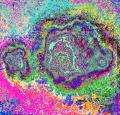
DMT-Nexus member
Posts: 1111 Joined: 18-Feb-2017 Last visit: 12-Jul-2024
|
When you put an acid in water, it dissociates, giving off H+ ions (HA -> H+ + A-).
Similarly, when you put a base in water, it dissociates, giving off OH- ions (B + H2O -> BH+ + OH−).
It's the H+ and OH- ions that make the solution acidic or basic. It's these ions we want. The dissociated molecule (A- or BH+) is garbage.
In the case of some acids and bases, the garbage molecule evaporates. Some common examples are acetic acid and ammonia. As you evaporate solutions of those, they smell, but eventually the smell disappears.
But what about the ions (H+ or OH-)? My understanding is that they don't evaporate. That means you can't neutralize your soup by evaporating it.
In particular:
- If you cook Ayahuasca with a lot of vinegar, and reduce your tea, it will only become more acidic, because the volume will decrease, but the amount of H+ ions will remain the same. The evaporation will rid it of its vinegar smell and taste, but not its acidity. And because of the smaller volume, it will become madly acidic.
- If you use ammonia to base your harmala alkaloids and evaporate it, the remaining powder will not have any ammonia in it, but it will be full of OH- ions and therefore be very alkaline... probably too alkaline to ingest safely without neutralizing first.
Is my understanding correct?
|
|
|
|
|

❤️🔥
 
Posts: 3648 Joined: 11-Mar-2017 Last visit: 02-Jun-2025 Location: 🌎
|
No, only the neutral molecule (HA or BOH) is evaporated. In the case of vinegar, it's boiling point is higher than water and it evaporates more slowly so its concentration will slightly increase while the mixture is evaporated. However, once dry it is all gone (while the acetic acid is gone, acetate salts would remain). Conversely, ammonia's boiling point is lower than water (it is a gas at room temp like HCl), so during evaporation concentration decreases (and again once dry only salts would remain). To get a feel for this see the attached a plot showing the decrease in weight of an ammonia solution as it evaporates under different fan speeds along with the plot for ammonia concentration. The concern when evaporating these acids/bases is the fumes. This ranges from annoying stinkiness (vinegar), to metal attack (HCl - which may have affected some Nexian's ovens). Loveall attached the following image(s):  Screenshot_20180311-082528.png (388kb) downloaded 155 time(s).
|
|
|

❤️🔥
 
Posts: 3648 Joined: 11-Mar-2017 Last visit: 02-Jun-2025 Location: 🌎
|
I forgot to mention you can do a residue test on pure acid or pure base to confirm it behaves as expected and dries clean. This may me useful if, for example, a manufacture adds surfactants to ammonia so it cleans better and doesn't label the product very well.
|
|
|

DMT-Nexus member
Posts: 1023 Joined: 19-Mar-2016 Last visit: 07-Apr-2024
|
Yes as Loveall stated. You cant evap an acid and leave its acidity. Also given the fact that acetic acid and ammonia are "Weak" acids and bases you can be pretty sure most of the molecules of COOHCH3 and NH3 will not be in their ion form Quote:The strength of an acid refers to its ability or tendency to lose a proton (H+). A strong acid is one that completely ionizes (dissociates) in a solution (provided there is sufficient solvent). In water, one mole of a strong acid HA dissolves yielding one mole of H+ (as hydronium ion H3O+ and higher aggregates) and one mole of the conjugate base, A−. Essentially, none of the non-ionized acid HA remains. Examples of strong acids are hydrochloric acid (HCl), hydroiodic acid (HI), hydrobromic acid (HBr), perchloric acid (HClO4), nitric acid (HNO3) and sulfuric acid (H2SO4). In aqueous solution, each of these essentially ionizes 100%. And acid only exerts its acidity in water or another solvent. H3O+ and OH- only remain in stable concentrations if you leave the acid in. This is what Le Chatelier's principle basically states. "Remove the acid and you remove the driving force of the H3O+ formation" Removing the acid will shift the balance back to normal as the only reason H3O+ forms is because of the acid. (and some H2O splitting on its own) And the only way the acid can give away its H+ is when its dissolved in water or if its in a salt. It will take back the H+ when its no longer in a salt or in a solution. HCl is a stable compound H+ and Cl- not stable when free (Radicals). The Cl- would just rip an H2O apart forming HCl and OH-. The OH- would then just recombine with the next H3O+ removing acidity.
|
|
|

DMT-Nexus member
Posts: 1104 Joined: 11-Feb-2017 Last visit: 18-Jan-2021
|
When this was explained in chemistry classes I always wondered how a pure isolated H3O+ would look like and behave. Would it be like water? Is it even possible to isolate it somehow?
|
|
|

DMT-Nexus member
Posts: 1111 Joined: 18-Feb-2017 Last visit: 12-Jul-2024
|
Loveall wrote:No, only the neutral molecule (HA or BOH) is evaporated. And the dissociated molecules and protons (in the case of acids) stay in solution? Or do they re-form bonds with lose protons to become neutral and then evaporate?
|
|
|

❤️🔥
 
Posts: 3648 Joined: 11-Mar-2017 Last visit: 02-Jun-2025 Location: 🌎
|
Jagube wrote:Loveall wrote:No, only the neutral molecule (HA or BOH) is evaporated. And the dissociated molecules and protons (in the case of acids) stay in solution? Or do they re-form bonds with lose protons to become neutral and then evaporate? I think both happen. In bulk, some remain dissociated and some re-bond in solution while evaporating. I'm honestly not 100% sure of the detailed dynamics and in chemistry the model of what is exactly happening can change as you dig deeper and seek more understanding. Someone else may be able to explain the situation better. That's why I posted the experimental plot  Another thing to consider is net charge. If the evaporate leaves protons behind a positive charge would build up in the acid which is not what happens.
|
|
|

DMT-Nexus member
Posts: 1023 Joined: 19-Mar-2016 Last visit: 07-Apr-2024
|
blue.magic wrote:When this was explained in chemistry classes I always wondered how a pure isolated H3O+ would look like and behave. Would it be like water? Is it even possible to isolate it somehow? Very acidic for sure. There are stable salts containing H3O+ like there are stable OH- salts. Quote:For example, hydrochloric acid has an ionization constant of 107, and mixtures with water at all proportions are liquid at room temperature. However, perchloric acid has an ionization constant of 1010, and if liquid anhydrous perchloric acid and water are combined in a 1:1 molar ratio, they react to form solid hydronium perchlorate (H3O+•ClO4-).
|
|
|

DMT-Nexus member
Posts: 1023 Joined: 19-Mar-2016 Last visit: 07-Apr-2024
|
Loveall wrote:Jagube wrote:Loveall wrote:No, only the neutral molecule (HA or BOH) is evaporated. And the dissociated molecules and protons (in the case of acids) stay in solution? Or do they re-form bonds with lose protons to become neutral and then evaporate? I think both happen. In bulk, some remain dissociated and some re-bond in solution while evaporating. I'm honestly not 100% sure of the detailed dynamics and in chemistry the model of what is exactly happening can change as you dig deeper and seek more understanding. Someone else may be able to explain the situation better. That's why I posted the experimental plot  Another thing to consider is net charge. If the evaporate leaves protons behind a positive charge would build up in the acid which is not what happens.  its difficult to explain really. Will try to explain in a way everybody understands now. Imagine water is a scale. On one side there is OH- and on the other side there is H3O+ In PH=7 they are both balanced. Now how are you able to increase the amount of each? Ulim attached the following image(s):  weight-scale-2402966_960_720.png (51kb) downloaded 68 time(s).
|
|
|

DMT-Nexus member
Posts: 1023 Joined: 19-Mar-2016 Last visit: 07-Apr-2024
|
By adding H+ (H3O+) or OH- (or removing protons from H2O) Then you shift the balance. For example by adding HCl in some concentration the balance tips. Now in this case the "weight" of the base or acid is calculated from their concentration and their respective pKa and pKb. (Which in turn is based on many other complicated factors like bond strenght etc and is also very wierd. For example HF is weaker than HCl) Now you have your acid in the bowl and the whole balance shifts. But if you remove it the balance will fall back again. Chemistry only seems easy on the surface. To go into detail would take forever. Ulim attached the following image(s):  doublepan-balance-scale-800x800.jpg (44kb) downloaded 67 time(s).
|